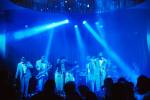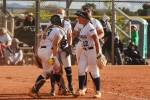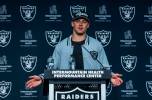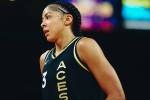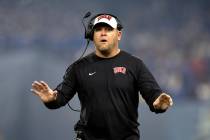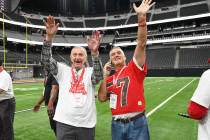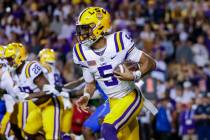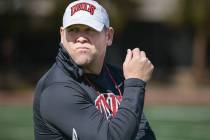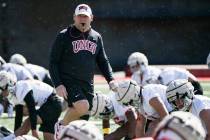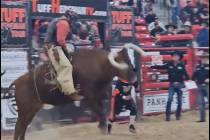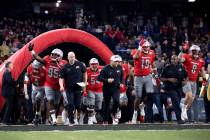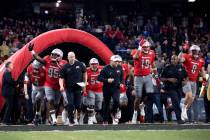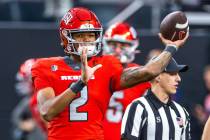UNLV faces crucial timeline before move to Raiders stadium


Having watched UNLV’s football program from its infancy, Chuck Davison has missed just 28 games in 50 years, sticking with the Rebels even as they routinely drove him to wonder if there were better ways to occupy his Saturdays.
He believes fans across the Las Vegas Valley should be as dedicated, but Davison is a realist when it comes to UNLV and its place in the local sports landscape.
Which makes two of his observations noteworthy. An early skeptic, he now believes the program is on the right track under coach Tony Sanchez. Davison, though, isn’t convinced a move into the new stadium in 2020 to join the Raiders will draw many fans beyond the euphoria of the first couple games.
“People won’t come to see the Rebels unless they’re winning,” he said. “We have a postage stamp in the stadium now.”
Those concerns aside, UNLV officials are committed to moving to the 65,000-seat stadium near the Strip, repeatedly saying it will bring a big recruiting boost for the program. They are going all in that this is the right move for the short- and long-term health of a program that has teetered between critical and serious condition for many years.
The Rebels’ future also is now, and how they play the remainder of this season and next will determine what momentum, if any, they carry into that stadium.
“Moving into one of the world’s premier football stadiums impacts every aspect of our football program,” athletic director Desiree Reed-Francois said. “When you combine the new stadium with the new Fertitta Football Complex, that really fuels that momentum, but make no mistake about it, we want to win now.”
Wins and losses
The Rebels, who open Mountain West play against New Mexico at 1 p.m. Saturday at Sam Boyd Stadium, need one more victory to give them at least three wins in four consecutive seasons. The last time they pulled that off was from 1999 to 2003 in the first five seasons under coach John Robinson.
UNLV, of course, has higher hopes. The Rebels (2-2) are striving to play in their first bowl in five years, and they have the talent to at least be in the conversation by the time a tough November schedule rolls around.
“I’m pleased with the progress overall that we’ve made,” Sanchez said. “When I look at our roster and you sit down and watch film and start game planning against people, it’s not so much smoke and mirrors. It’s not so much, ‘Oh, man, how are we going to handle this matchup? How are we going to handle that matchup?’ You still have a little of that because everybody has an elite guy here and there, but it’s not rampant.”
Sanchez is easily the program’s most successful coach since Robinson, having won 35 percent (14-26) of his games — his two predecessors were Mike Sanford (27.1 percent) and Bobby Hauck (23.4 percent). Such futility speaks to the structural difficulties in trying to win at a place that counts only four bowl appearances in its history.
But with the genuine hope of becoming bowl eligible this season, reaching the postseason is especially important. Should the Rebels falter, it would invite unwanted questions about the futures of Sanchez and the program.
“It’s a critical season because it’s his fourth year,” said former standout running back Joe Haro, now president of the UNLV Football Foundation. “He’s got a lot of his guys. He’s got more depth than he’s ever had. And they’ve got a great chance. They’ve got a very favorable schedule, and I think they’re set up to make a really solid run at a bowl game this year.
“It’s critical because if you do that, it will help with recruits. Next year, they’ve got another great opportunity. You’re setting yourself up to be a consistent bowl attendee every year, and 2020 it’s on, right? The Raiders are going to be here. You’re going to have the best stadium in all of college football, and the best stadium in the NFL.”
Should the Rebels make the postseason this year, talk will turn to the next step of competing for a Mountain West title. Of not just hoping to get to six wins and bowl eligibility, but of seriously pushing Fresno State and San Diego State in the West Division and ultimately conference kingpin Boise State.
“We have an expectation for all of our programs that we are going to be very successful in conference, but that’s not where we’re going to stop,” Reed-Francois said. “We want to be successful not only in the Mountain West conference but beyond, and we’re going to provide those resources for our teams to be successful.”
Fan support
UNLV’s long run of losing, interrupted by brief bowl appearances, has soured and chased away fans.
Even with one of its better teams this season — including a marquee running back in Lexington Thomas — announced crowds for the first two home games didn’t crack 15,000. It was similar to five years ago when the Rebels last made a bowl, and yet a crowd of just 15,884 showed up for the regular-season finale against San Diego State in which the Rebels shined in a 45-19 rout.
UNLV’s fan base will never be confused for Alabama’s, but the Rebels used to draw relatively large crowds for the more notable games. Four of the top five average home crowds occurred in the 2000s, and the other was in 1981. The Rebels haven’t attracted average crowds of more than 20,000 since 2011.
To establish a genuine home-field advantage, UNLV needs sustained success and at a high level.
“It has to be fun for people to come out there,” said Davison, the former two-time UNLV Football Foundation president. “It’s nothing like the Golden Knights. Do you really believe the Golden Knights would be that big if they were not winners? Not at all.
“I’ve been here my whole life, my family since 1927, and they don’t support you unless you’re winning.”
Facilities
Moving to the new stadium is part of the sell to fans and recruits that the program is progressing. So is the Fertitta Football Complex, which is under construction adjacent to the Rebel Park practice fields and scheduled to open next spring.
But UNLV is still fund-raising to make up an approximate $5 million deficit to finish the interior of the second floor. What was supposed to be a recruiting advantage with the $31 million building very well could be used against UNLV until the money comes through.
“We’re going to build to the money that we have,” Reed-Francois said. “The good thing is is that we have the foundation. We’re going to have a great facility that will meet the needs of our student-athletes, and as we raise more money for the program, we’ll add more bells and whistles. But right now we have the funding to provide a functional, very special building that’s worthy of the Fertitta name and worthy of the program that we’re building.”
Haro said he reached out to other former players through Facebook and Instagram asking for $100 contributions to assist with the project. Some ex-Rebels responded, and Haro is hopeful more will dig into their pockets.
“We really have to keep in mind that especially those of us that played here, it’s important to give what we can, to do what we can to make sure that this program remains relevant and continues to have a chance to be successful,” he said. “It’s been tough treading for many years, but I feel like we’re really close.
“It’s not as much as I would’ve hoped. But it’s a marathon, not a sprint.”
More Rebels: Follow all of our UNLV coverage online at reviewjournal.com/Rebels and @RJ_Sports on Twitter.
Contact Mark Anderson at manderson@reviewjournal.com. Follow @markanderson65 on Twitter.
UNLV football coaches
(By winning percentage)
Ron Meyer (1973-75), 27-8, 77.1
Tony Knap (1976-81), 47-20-2, 69.6
Harvey Hyde (1982-85), 26-19-1, 57.6
Bill Ireland (1968-72), 26-23-1, 53.0
Wayne Nunnely (1986-89), 19-25, 43.2
John Robinson (1999-2004), 28-42, 40.0
Jim Strong (1990-93), 17-27, 38.6
Tony Sanchez (2015-present), 14-26, 35.0
Mike Sanford (2005-09), 16-43, 27.1
Bobby Hauck (2010-14), 15-49, 23.4
Jeff Horton (1994-98), 13-44, 22.8




